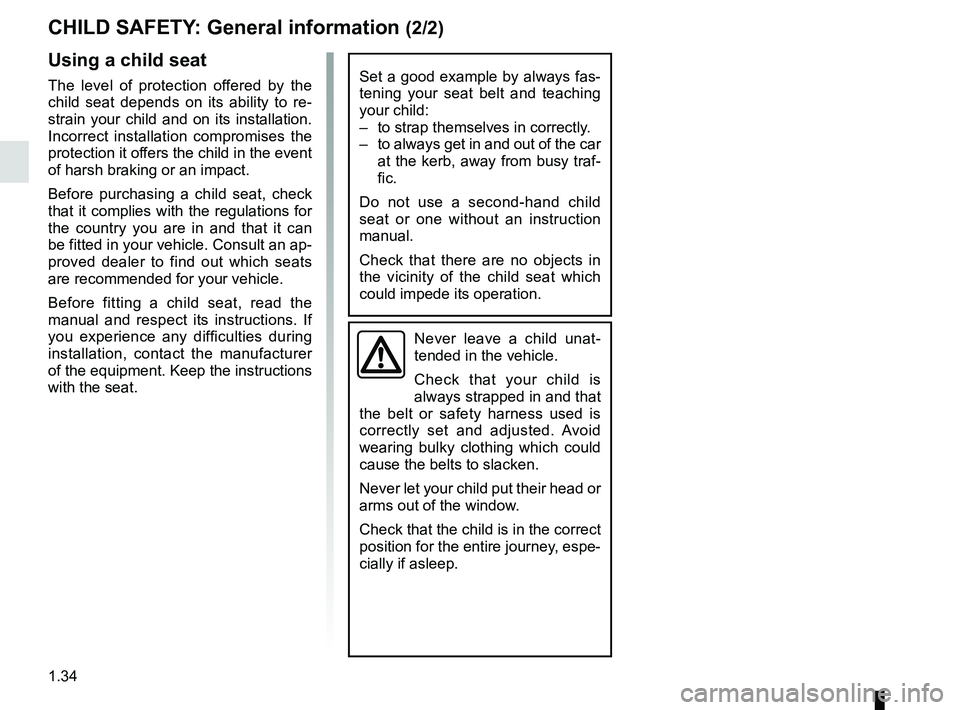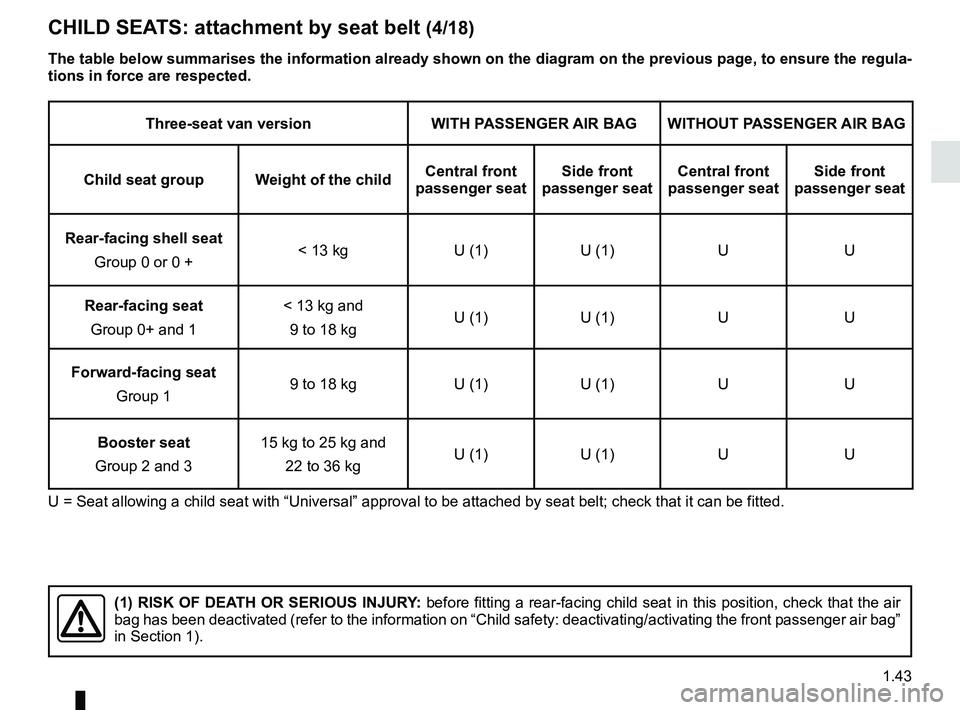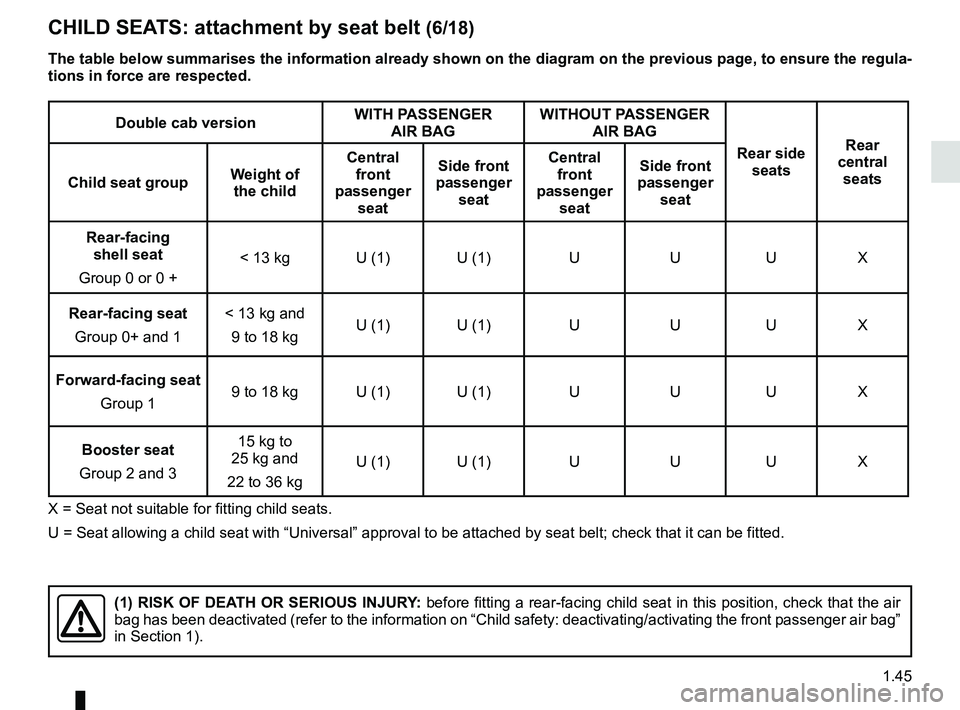Page 39 of 290

1.33
CHILD SAFETY: General information (1/2)
Carrying children
Children, and adults, must be correctly
seated and strapped in for all journeys.
The children being carried in your vehi-
cle are your responsibility.
A child is not a miniature adult. Children
are at risk of specific injuries as their
muscles and bones have not yet fin-
ished growing. The seat belt alone
would not provide suitable protection.
Use an approved child seat and ensure
you use it correctly.
A collision at 30 mph
(50 km/ h) is the same
as falling a distance of
10 metres. Transporting a
child without a restraint is the equiv-
alent of allowing him or her to play
on a fourth-floor balcony without
railings.
Never travel with a child held in your
arms. In the event of an accident,
you will not be able to keep hold of
the child, even if you yourself are
wearing a seat belt.
If your vehicle has been involved
in a road accident, replace the
child seat and have the seat belts
checked.
To prevent the doors being
opened, use the childproof
locks (please refer to the in-
formation on “Locking/un-
locking the doors” in Section 1).
Driver’s responsibility
when parking or stopping
the vehicle
Never leave an animal,
child or adult who is not self-suffi-
cient alone on your vehicle, even for
a short time.
They may pose a risk to themselves
or to others by starting the engine,
activating equipment such as the
electric windows or by locking the
doors.
Also, in hot and/or sunny weather,
please remember that the tempera-
ture inside the passenger compart-
ment increases very quickly.
RISK OF DEATH OR SERIOUS
INJURY.
Page 40 of 290

1.34
CHILD SAFETY: General information (2/2)
Using a child seat
The level of protection offered by the
child seat depends on its ability to re-
strain your child and on its installation.
Incorrect installation compromises the
protection it offers the child in the event
of harsh braking or an impact.
Before purchasing a child seat, check
that it complies with the regulations for
the country you are in and that it can
be fitted in your vehicle. Consult an ap-
proved dealer to find out which seats
are recommended for your vehicle.
Before fitting a child seat, read the
manual and respect its instructions. If
you experience any difficulties during
installation, contact the manufacturer
of the equipment. Keep the instructions
with the seat.
Never leave a child unat-
tended in the vehicle.
Check that your child is
always strapped in and that
the belt or safety harness used is
correctly set and adjusted. Avoid
wearing bulky clothing which could
cause the belts to slacken.
Never let your child put their head or
arms out of the window.
Check that the child is in the correct
position for the entire journey, espe-
cially if asleep.
Set a good example by always fas-
tening your seat belt and teaching
your child:
– to strap themselves in correctly.
– to always get in and out of the car at the kerb, away from busy traf-
fic.
Do not use a second-hand child
seat or one without an instruction
manual.
Check that there are no objects in
the vicinity of the child seat which
could impede its operation.
Page 47 of 290
1.41
CHILD SEATS: attachment by seat belt (2/18)
Two-seat van versionWITH PASSENGER AIR BAGWITHOUT PASSENGER
AIR BAG
Child seat group Weight of the child Front passenger seatFront passenger seat
Rear-facing shell seat Group 0 or 0 + < 13 kg
U (1) U
Rear-facing seat Group 0+ and 1 < 13 kg and
9 to 18 kg U (1)
U
Forward-facing seat Group 1 9 to 18 kg
U (1) U
Booster seat
Group 2 and 3 15 kg to 25 kg and
22 to 36 kg U (1)
U
U = Seat allowing a child seat with “Universal” approval to be attache\
d by seat belt; check that it can be fitted.
(1) RISK OF DEATH OR SERIOUS INJURY: before installing a child seat on the front passenger seat, check that \
the
air bag has been deactivated (refer to "Child safety: front passenger a\
ir bag deactivation/activation" Section 1).
The table below summarises the information already shown on the diagram \
on the previous page, to ensure the regula-
tions in force are respected.
Page 49 of 290

1.43
CHILD SEATS: attachment by seat belt (4/18)
Three-seat van versionWITH PASSENGER AIR BAG WITHOUT PASSENGER AIR BAG
Child seat group Weight of the child Central front
passenger seat Side front
passenger seat Central front
passenger seat Side front
passenger seat
Rear-facing shell seat Group 0 or 0 + < 13 kg
U (1)U (1) UU
Rear-facing seat Group 0+ and 1 < 13 kg and
9 to 18 kg U (1)
U (1) UU
Forward-facing seat Group 1 9 to 18 kg
U (1)U (1) UU
Booster seat
Group 2 and 3 15 kg to 25 kg and
22 to 36 kg U (1)
U (1) UU
U = Seat allowing a child seat with “Universal” approval to be attache\
d by seat belt; check that it can be fitted.
(1) RISK OF DEATH OR SERIOUS INJURY: before fitting a rear-facing child seat in this position, check that th\
e air
bag has been deactivated (refer to the information on “Child safety:\
deactivating/activating the front passenger air bag”
in Section 1).
The table below summarises the information already shown on the diagram \
on the previous page, to ensure the regula-
tions in force are respected.
Page 51 of 290

1.45
CHILD SEATS: attachment by seat belt (6/18)
Double cab versionWITH PASSENGER
AIR BAG WITHOUT PASSENGER
AIR BAG
Rear side seats Rear
central seats
Child seat group Weight of
the child Central
front
passenger seat Side front
passenger seat Central
front
passenger seat Side front
passenger seat
Rear-facing shell seat
Group 0 or 0 + < 13 kg U (1) U (1) U U U X
Rear-facing seat Group 0+ and 1 < 13 kg and
9 to 18 kg U (1) U (1) U U U X
Forward-facing seat Group 1 9 to 18 kg U (1) U (1) U U U X
Booster seat
Group 2 and 3 15 kg to
25 kg and
22 to 36 kg U (1) U (1) U U U X
X = Seat not suitable for fitting child seats.
U = Seat allowing a child seat with “Universal” approval to be attache\
d by seat belt; check that it can be fitted.
(1) RISK OF DEATH OR SERIOUS INJURY: before fitting a rear-facing child seat in this position, check that th\
e air
bag has been deactivated (refer to the information on “Child safety:\
deactivating/activating the front passenger air bag”
in Section 1).
The table below summarises the information already shown on the diagram \
on the previous page, to ensure the regula-
tions in force are respected.
Page 52 of 290
1.46
CHILD SEATS: attachment by seat belt (7/18)
5-seater Combi versionFront seatsRear seats
Child seat group Weight of
the child WITH
PASSENGER AIRBAG (3) WITHOUT
PASSENGER AIR BAG 2nd row side seats
2nd row
centre seat
Behind
driver Behind
front
passenger
Carrycot fitted across
the vehicle
Group 0 < 10 kg
XXXX X
Rear-facing shell seat
Group 0 or 0 + < 13 kg
UUU (1) XX
Rear-facing seat
Group 0+ and 1 < 13 kg and
9 to 18 kg U
UU (1) XX
Forward-facing seat
Group 1 9 to 18 kg
UU (2) U (2) UF (2) UF (2)
Booster seat
Group 2 and 3 15 kg to
25 kg and
22 to 36 kg U (2)
U (2)U (2) UF (2) UF (2)
The table below summarises the information already shown on the diagram \
on the next page, to ensure the regulations
in force are respected.
Page 56 of 290
1.50
CHILD SEATS: attachment by seat belt (11/18)
6-seater Combi versionFront seatsRear seats
Child seat group Weight of
the child WITH PASSENGER
AIRBAG (3) WITHOUT
PASSENGER AIR BAG 2nd row side seats
2nd row
centre seat
central side central side Behind
driver Behind front
passenger
Carrycot fitted
across the vehi-
cle
Group 0 < 10 kg X X X X X
XX
Rear-facing shell
seat
Group 0 or 0 + < 13 kg U U U U U (1)
XX
Rear-facing seat
Group 0+ and 1 < 13 kg and
9 to 18 kg U U U U U (1)
XX
Forward-facing
seat
Group 1 9 to 18 kg U (2) U (2) U (2) U (2) U (2) UF (2) UF (2)
Booster seat
Group 2 and 3 15 kg to
25 kg and
22 to 36 kg U (2) U (2) U (2) U (2) U (2) UF (2) UF (2)
The table below summarises the information already shown on the diagram \
on the previous page, to ensure the regula-
tions in force are respected.
Page 58 of 290
1.52
CHILD SEATS: attachment by seat belt (13/18)
8-seater Combi versionFront seatsRear seats
Child seat group Weight of
the child WITH PASSENGER
AIRBAG (1) WITHOUT
PASSENGER AIR BAG 2nd row side seats
2nd row centre seat 3rd
row
central centralBehind
driver Behind front
passenger
Carrycot fitted
across the vehi-
cle
Group 0 < 10 kg
X XXXX X
Rear-facing shell
seat
Group 0 or 0 + < 13 kg
U UU (1) X X X
Rear-facing seat
Group 0+ and 1 < 13 kg and
9 to 18 kg U
UU (2) X X X
Forward-facing
seat
Group 1 9 to 18 kg
U (2) U (2)U (2) UF (2) UF (2) X
Booster seat
Group 2 and 3 15 kg to
25 kg and
22 to 36 kg U (2)
U (2)U (2) UF (2) UF (2) X
The table below summarises the information already shown on the diagram \
on the next page, to ensure the regulations
in force are respected.